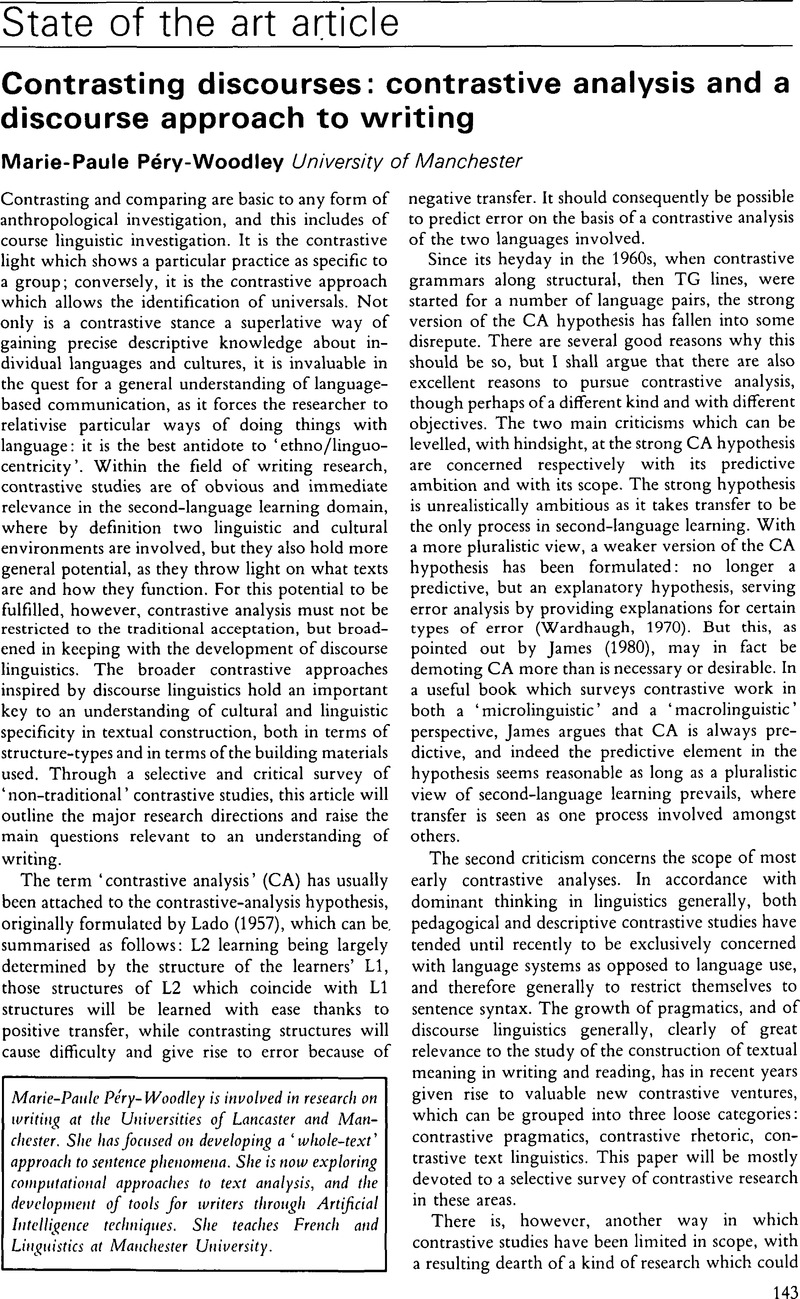Crossref Citations
This article has been cited by the following publications. This list is generated based on data provided by Crossref.
Péry-Woodley, Marie-Paule
1991.
French and English passives in the construction of text.
Journal of French Language Studies,
Vol. 1,
Issue. 1,
p.
55.
Péry-Woodley, Marie-Paule
1991.
Writing in L1 and L2: analysing and evaluating learners' texts.
Language Teaching,
Vol. 24,
Issue. 2,
p.
69.
Duszak, Anna
1997.
Culture and Styles of Academic Discourse.
p.
323.
Evans, Karin U.H.
1998.
Organizational patterns of American and German texts for business and economics: A contrastive study.
Journal of Pragmatics,
Vol. 29,
Issue. 6,
p.
681.
Simpson, JoEllen M.
2000.
Topical Structure Analysis of Academic Paragraphs in English and Spanish.
Journal of Second Language Writing,
Vol. 9,
Issue. 3,
p.
293.
Archibald, Alasdair
and
C. Jeffery, Gaynor
2000.
Second language acquisition and writing:.
Learning and Instruction,
Vol. 10,
Issue. 1,
p.
1.
Cahill, David
2003.
The Myth of the “Turn” in Contrastive Rhetoric.
Written Communication,
Vol. 20,
Issue. 2,
p.
170.
Machniewski, Maciej
2004.
Contrastiue functional analysis as a starting point for corpus-based translation studies (CTS): Methodological considerations for analysing small transiational corpora.
Language Matters,
Vol. 35,
Issue. 1,
p.
102.
Bagwasi, Mompoloki M.
2008.
Pragmatics of letter writing in Setswana.
Journal of Pragmatics,
Vol. 40,
Issue. 3,
p.
525.
Gries, Stefan Th.
and
Adelman, Allison S.
2014.
Yearbook of Corpus Linguistics and Pragmatics 2014.
Vol. 2,
Issue. ,
p.
35.
Granger, Sylviane
2015.
Contrastive interlanguage analysis.
International Journal of Learner Corpus Research,
Vol. 1,
Issue. 1,
p.
7.
Tåqvist, Marie Kristin
2018.
“A wise decision”: Pre-modification of discourse-organising nouns in L2 writing.
Journal of Second Language Writing,
Vol. 41,
Issue. ,
p.
14.
Kumar, Vipul
Kohli, Neena
and
Tripathi, Pankaj
2022.
Climate Change, Disaster and Adaptations.
p.
183.
Wei, Xing
2023.
Exploring the Cross-Language Transfer of L1 Rhetorical Knowledge in L2 Writing.
p.
13.
Gries, Stefan Th.
2024.
Against level-3-only analyses in corpus linguistics.
ICAME Journal,
Vol. 48,
Issue. 1,
p.
23.



